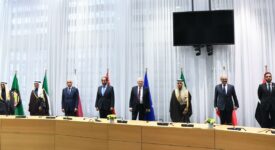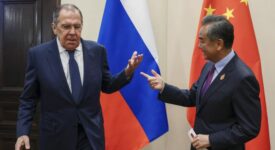While we need to cast a more critical eye on what Europe can actually bring to the Indo-Pacific, it is too early to dismiss Europe’s military engagement in the region. As the UK carrier strike group, led by HMS Queen Elizabeth, brand new and the biggest Royal Navy vessel ever built, arrives in the South China Sea and the Western Pacific, an old and fundamental debate rages once again. It is about the value of European military engagement in the Indo-Pacific, whether Europe should be in the Indo-Pacific along with the United States, or whether it would be better advised to stay in Europe and use its scarce resources to address security challenges there.
U.S. Secretary of Defense, Lloyd Austin stated in Singapore – just when HMS Queen Elizabeth was off the coast of the Garden City – that “we are not only looking to help each other in the Indo-Pacific” and “if we focus a bit more here [in Asia], are there areas in which the UK can be more helpful in other parts of the world.” The Financial Times reported this comment as Austin expressed doubt about the value of the UK’s engagement in the Indo-Pacific region. “Better to have Europe play to its strengths in the Euro-Atlantic area rather than to vainly try to project meaningful military power to the Asia-Pacific,” argues Elbridge Colby. Likewise, Eric Sayers argues that “It may seem counterintuitive for democracies to shy away from assisting one another, but the best contribution European countries can make to a global alliance strategy for deterring great powers is to prioritize their finite resources for Russia.” This way the US could lessen its burden in Europe and its neighborhood, making it possible to concentrate more on China.
This is basically the idea of a “geographical division of labor.” Given the geographical distance, particularly between Europe and Asia, and the scarce nature of European defense assets and resources, it sounds tempting and logical or, at least, inevitable. Europe cannot even hope to affect the balance of power in the Indo-Pacific region. However, there are risks with this thinking, and some dissonances with the reality on the ground.
First, a situation in which different allies focus on different threats and challenges in different theaters will lead to wider perception gaps among them, making it more difficult to achieve cooperation on China, Russia or other strategic agendas. This is inconsistent with the Biden administration’s basic approach of dealing with its allies, which is “consult together, decide together and act together,” as pronounced by Lloyd Austin. Washington has been trying to have NATO, the EU and the G7 pay more attention to China. The aim is to generate shared perceptions and the idea of geographical division of labor will directly undermine such efforts, because the implicit message would be “you don’t need to worry about China.”
Second, and related to the above, even if the US may not currently need military help from Europe in the Indo-Pacific region, it already needs to get Europe and other allies and partners on board in its technological competition with China, a competition that encompasses emerging and disruptive technologies, digital data, export control and investment screening. How can coordination and cooperation in these areas with Europe be possible if Europe keeps focusing on Russia as its main security threat and remains indifferent to the security challenges posed by China?
Third, geographical distance can no longer be a shield for Europe to protect itself from the consequences of China’s behavior. NATO Secretary General Jens Stoltenberg warns that “China is coming closer to us” in cyber and other domains. Maritime security has also become Europe’s direct concern, because Europe is and will be affected by what happens in the South and East China Seas, pushing some European countries to send their navy vessels to the Indo-Pacific region. In other words, Europe is in Asia essentially for its own interest, not for the U.S. interest, although alignment with the US is often part of Europe’s considerations.
Fourth, while the Biden administration has yet to come up with a clear idea about what it expects Europe to do in military terms in the Indo-Pacific region, the reality on the ground (and at and under the sea) is that the U.S. military has for some time been quite active in enabling European engagement in the Indo-Pacific, through providing the necessary logistical support to visiting vessels. American participation in the UK-led carrier strike group – 10 F-35B fighter jets and a destroyer – is testament to Washington’s firm commitment to the British “tilt” to the Indo-Pacific.
To conclude, while we certainly need to cast a more critical eye on what Europe can actually bring to the Indo-Pacific, it is too early to dismiss Europe’s military engagement in the region. The United States, along with Japan and other U.S. allies and partners in the region explicitly welcome and facilitate European engagement in the region. How to strike a balance between engagement in the Indo-Pacific region and the role in Europe and its neighborhood is something for Europe – the UK, France and other individual countries as well as the EU – to consider and decide. Yet it cannot be an “either or” question. Europe needs to do both as long as both are important for its own security.
‘Europe in Europe, America in Asia?’ — Commentary by Tsuruoka Michito — The Diplomat.







